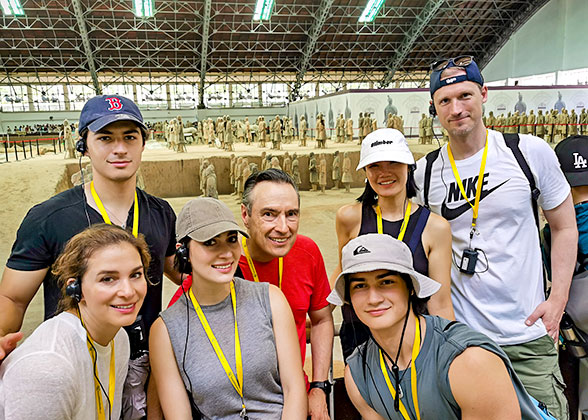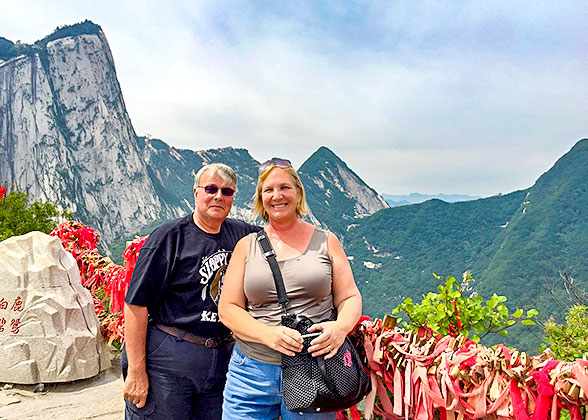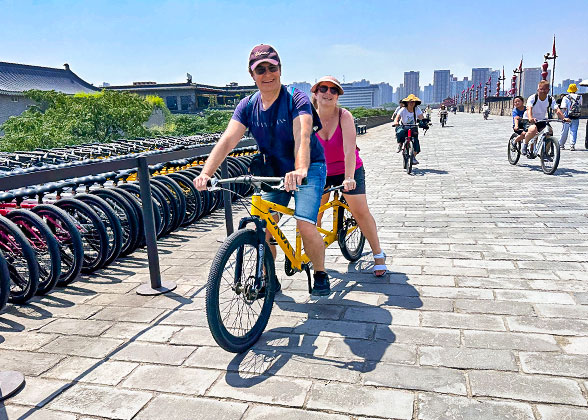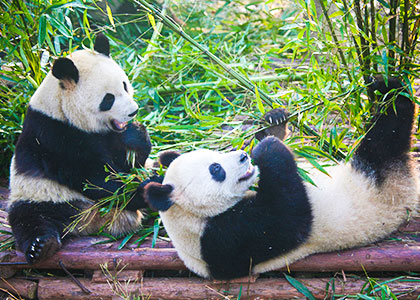
This exhibition hall will be temporarily closed from mid-December 2025 to mid-January 2026 due to the museum's renovation and upgrade.
The Treasures of the Great Tang Dynasty (618 - 907) is located on the west side of the first floor of the Shaanxi History Museum, which is also the No. 4 Exhibition Hall. It mainly showcases over 300 Tang Dynasty artifacts unearthed from Hejia Village in the southern suburbs of Xi’an in 1970.
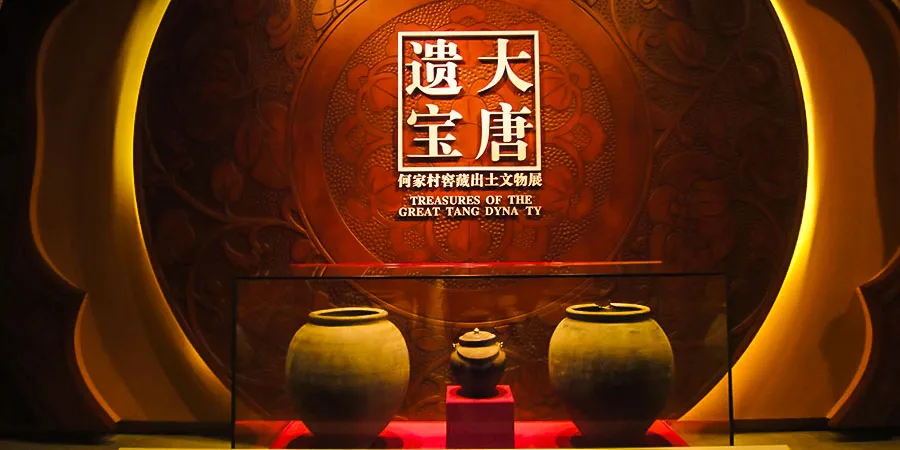 |
| Two Jars and One Silver Pot |
The Tang Dynasty, a pinnacle of glory, prosperity, and openness in Chinese history, left behind an extraordinary collection of exquisite and invaluable relics. The interesting saying, “One Hejia Village could buy half of Hong Kong,” vividly captures the Hejia Village hoard’s preciousness and unparalleled significance. Through the numerous exquisite gold and silver wares and jade wares in the exhibition hall, tourists can have a clearer perception of the affluent and luxurious life of the Tang people and their superb craftsmanship.
 Photos of Relics of Sui & Tang Dynasties
Photos of Relics of Sui & Tang Dynasties How were These Cultural Relics Discovered and Who Do They Belong to?
In October 1970, construction workers stumbled upon a large earthenware jar and a silver pot during a project, both containing gold, silver, and jewels. Further excavation revealed a second jar, ultimately yielding over 1,000 Tang Dynasty relics across these two jars and one silver pot, including gold and silver wares, jade ornaments, rare medicinal herbs, and Chinese and foreign currencies. Among these, over 300 masterpieces are displayed in this hall.
Who buried these treasures, and for what purpose? Based on expert analysis, the likely owner of this hoard of buried treasures was Liu Zhen, who served as the Rent and Labor Service Commissioner during the Tang Dynasty. This position was tantamount to the top official overseeing national taxation, endowing its holder with considerable authority. Historical records indicate that Liu Zhen lived near Hejia Village. It is plausible that the military rebellion erupted so unexpectedly that, in his haste, Liu Zhen was unable to evacuate all his gold and silver. As a result, he buried the valuables temporarily, intending to retrieve them after the war ended. Regrettably, he perished amidst the chaos of war, causing these treasures to remain forgotten underground until their discovery in modern times.
What to See at the Treasures of the Great Tang Dynasty?
1. Gold and Silver Articles
The most dazzling treasures from the Hejia Village hoard are the gold and silver cups, plates, and bowls that radiate the opulence of the Tang Dynasty. To modern eyes, they may seem excessively luxurious as dining utensils, but to the Tang people, they were believed to embody the power of longevity. In Chang’an over a millennium ago, the powerful and wealthy people subscribed to the belief that “gold and silver dining vessels grant immortality.” From gold bowls to silver jars, these intricately decorated pieces served not only as functional ware but also as symbols of wealth and refinement.
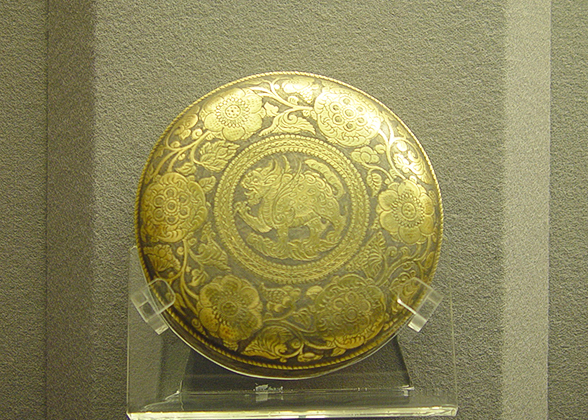 | | Golden Cup | | 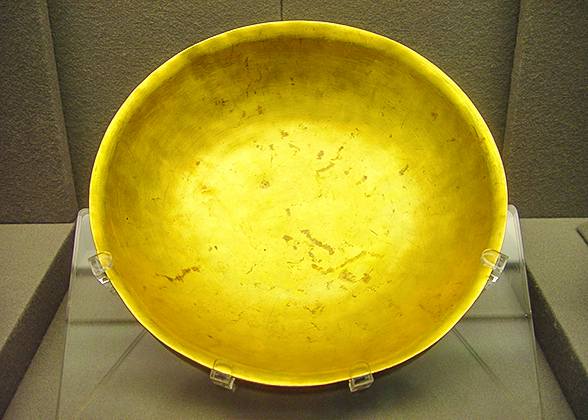 | | Gold Basin | |

Gold Bowls with Mandarin Ducks and Lotus Petals
The Gold Bowls with Mandarin Ducks and Lotus Petals are a pair and are national treasures. The surface of the gold bowls features two layers of outwardly protruding lotus petal patterns, with ten petals in each layer. Each lotus petal is engraved with different patterns. The upper layer features animal patterns such as mandarin ducks and parrots, while the lower layer has patterns of honeysuckle. These bowls were not only used by Tang Dynasty nobles for drinking but also served as objects for appreciation and enjoyment.

Gilt Silver Jar with Dancing Horse Holding a Cup
Inspired by nomadic leather flasks, this jar showcases exquisite forging and gilding techniques. Its surface features a relief of a dancing horse kneeling with a cup in its mouth, said to have been created for Emperor Tang Xuanzong’s “Thousand-Year Banquet,” where dancing horses allegedly performed this ritual to honor the emperor.
 | | Gold Bowls with Mandarin Ducks and Lotus Petals | | 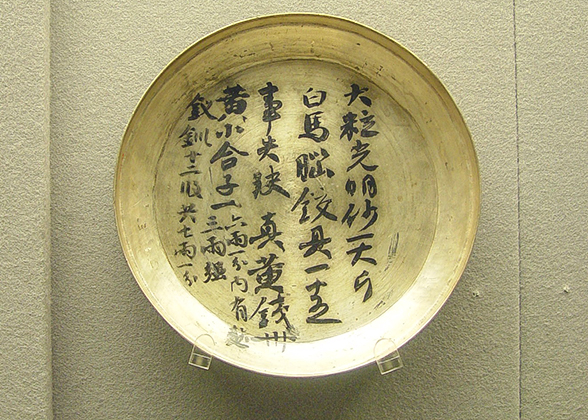 | | Gilt Silver Jar with Dancing Horse Holding a Cup | |

Agate Cup with Animal Head
This cup is shaped like the head of a horned beast, with its two horns serving as handles and the extended neck forming the vessel. The design is extremely unique, made of banded agate, a material that is extremely rare and particularly precious. The gold cap on the mouth is also highly innovative, shining with a golden luster and exuding magnificence. Such a design was not related to China in its early days; it was one of the foreign artifacts brought by envoys, serving as a testament to the friendly exchanges between China and foreign countries.
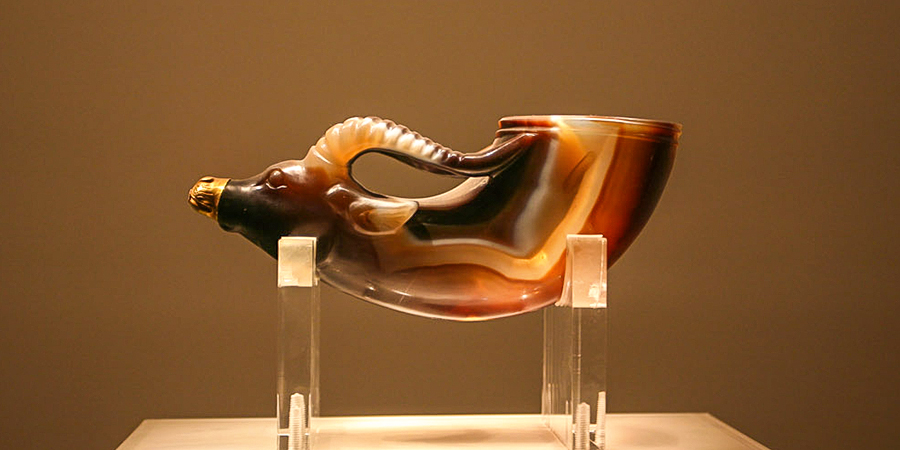 |
| Agate Cup in the Shape of An Ox with A Gold Mouth |

Sliver Jar with a Loop Handle and Gilt Parrots
The Sliver Jar with a Loop Handle and Gilt Parrots is crafted using the “gold-wire inlaid” technique, weaving 0.2-millimeter (0.008-inch) gold wires into intricate patterns. Even more astonishingly, under a microscope, the clear concentric circular lathe marks on the surface can be seen, indicating that primitive lathe equipment had already emerged at that time. These techniques were ahead of Europe by nearly a thousand years. Even if modern artisans replicate those using traditional methods, it is difficult to fully restore their charm.

Silver Incense Burner with Design of Grapes, Flowers and Birds
In people’s impression, an incense bag might be an item similar to a sachet. What is special about the Silver Incense Burner is that it is composed of an outer silver ball and an inner incense cup, with a 7.5-cm (3.0-inch) chain attached. The entire incense burner features a latticed design and is connected by a flexible hinge, allowing it to be fixed flexibly. Amazingly, no matter in which direction you tilt it, the inner gold incense cup will always remain balanced. Moreover, in the Tang Dynasty, the grape species had not yet been introduced to China. Therefore, the presence of grapes as an imported product is also physical evidence of the prosperous trade along the
Silk Road.
 | | Sliver Jar with a Loop Handle and Gilt Parrots | | 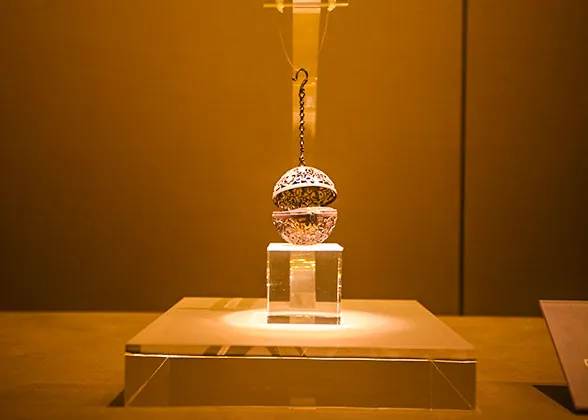 | | Silver Incense Burner | |
Upon entering the Treasures of the Great Tang Dynasty, a row of exquisitely crafted jade belts, head ornaments, and other jade items catch your eyes. They feature patterns such as cloud, lotus, dragon, phoenix, and lion, giving a sense of grandeur and magnificence. The jade belt is known as the “Hermès of the Tang Dynasty,” and only high-ranking officials could wear it, symbolizing their status. There are not many Tang Dynasty jade items that have survived to this day. Every piece on display here is exquisite, a masterpiece, and of great ornamental value.

White Jade Belt Plaque with Design of a Lion
The White Jade Belt Plaque with Design of a Lion is composed of 16 jade plaques, each featuring a lion in a different posture. The lions are depicted either standing or lying down, with some raising their heads and others lowering them. The meticulous carvings and ingenious design, infused with strong Central Asian influences, reflect the Tang Dynasty’s multicultural aesthetic.
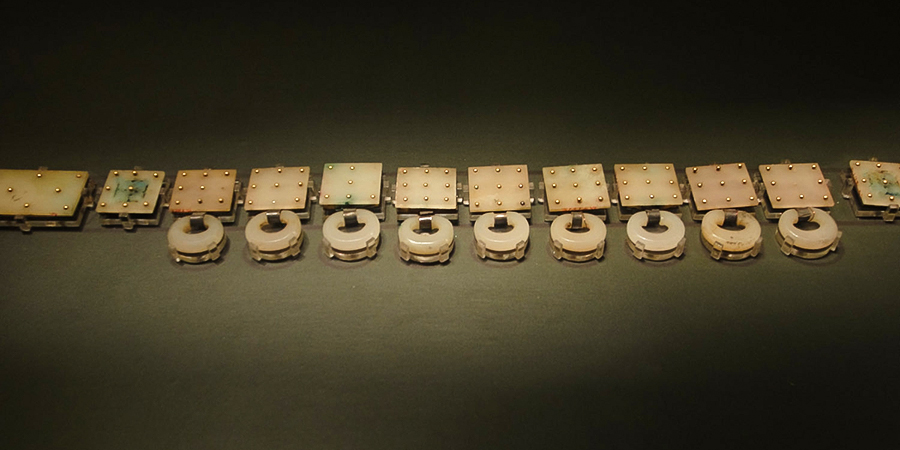 | | White Jade Belt Plaque with Design of a Lion | | 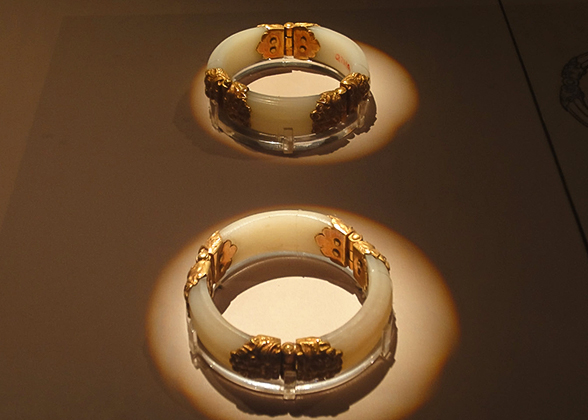 | | Jade Armlets | |
3. Coins in Different Dynasties and Different Countries
This hall houses a collection of precious Chinese and foreign coins. Among them, the Chinese coins span from the Spring and Autumn Period (770 BC - 476 BC) to the Tang Dynasty, covering a time span of over a thousand years. The types of coins are diverse, with at least one from each dynasty, making it a “repository of specimens of ancient Chinese coins”. The most eye-catching are 30 gold coins of early Tang, which were non-circulating currency specifically used to reward foreign envoys. The Japanese coin dating back 1,300 years ago unearthed from the hoard is even more remarkable, as it serves as the earliest physical evidence of Sino-Japanese exchanges. Through these coins, it can be seen that the economy of the Tang Dynasty was open and there were trade exchanges with various countries.

Silver Ingot with Inscription Indicating Its Place of Production
This silver coin is quite unique. There is a circular “patch” on its surface, meaning a small piece of silver was added to it. The surface is inscribed with “Ten Taels of Silver”. After being weighed by archaeologists, it was confirmed that the weight of this coin is exactly ten taels. Clearly, this patch was added to make up for the insufficient weight of the coin, proving that in the Tang Dynasty, the coin in the national treasury had to be of full weight. It is hard to imagine that the management of currency in China a thousand years ago had reached such a precise level
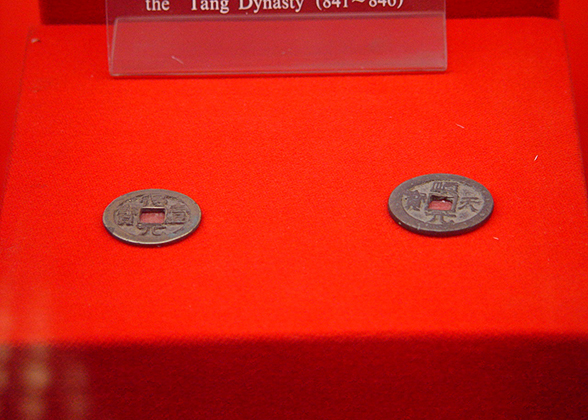 | | Coins of Early Tang | | 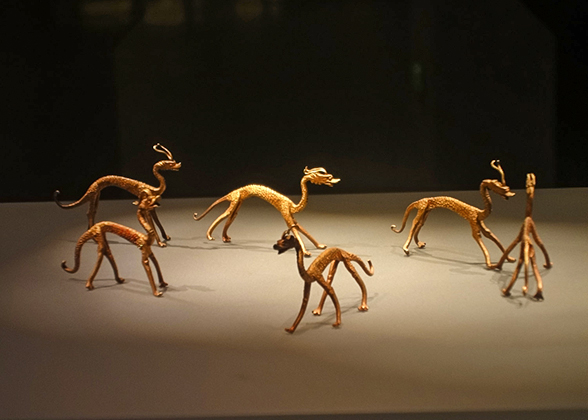 | | Silver Ingot with a Patch | |
Go to the Exhibition Hall for Murals Treasures of Tang Dynasty
- Last updated on Oct. 14, 2025 by Sherry Xia -












